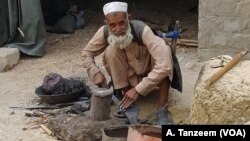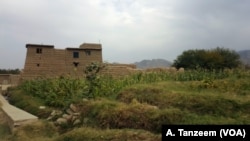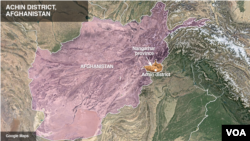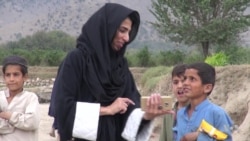The local police commander pointed toward a graveyard. Several of the graves lay partly open.
“We dug up the graves to show the locals these Daesh fighters were no martyrs. Their bodies were eaten by insects and smelled bad,” Bilal Bacha, the commander said, using an Arabic acronym to describe Islamic State.
He was referring to a belief in Islamic thought that a martyr’s body never decomposes and always smells like musk.
Further down, a two-story building with thick mud walls that used to be an IS prison is now empty. Piles of rubble indicated houses where IS commanders once lived. NATO had bombed most of them.
The area in the Pekha valley of Achin district, in eastern Afghanistan's Nangarhar province, was once a stronghold of the Islamic State group. Early in 2015, when it started gaining ground, its tactics were so brutal, locals considered the Taliban tame by comparison. Many fled the area.
“Life was so difficult that we took our stuff and moved to another area. We’ve just returned around five months ago,” said a man, who, judging from his signature brimless white cotton cap, looked like he was from the Shinwari tribe. The Shinwaris, being one of the largest groups in the area, had suffered the most at the hands of IS. They were trying to pick up the pieces.
WATCH: Afghan Village Looks to Life Beyond Daesh in Recently Cleared Areas
In a small village called Lataband Tangi, children, including little girls, ran around, excited to see outsiders. Some tried to sneak up behind the VOA photographer to take a peek at his viewfinder. Such scenes would have been impossible a year ago.
Along the way, women confined to their houses under IS rule now could be seen working in vegetable gardens by the roadside, or walking their animals to the nearest stream.
The local bazaar was a tiny row of dirty old brick rooms. Only half of them were open. A small pile of clear plastic bags full of vegetables and fruits lay on the floor next to an old man grinding an axe. He smiled as he looked up, his experienced hands continuing the work as he observed his surroundings.
People were beginning to think beyond survival to other issues.
“Our biggest problems after the departure of the Islamic State are health and education,” said a man standing by the roadside. “Plus, the houses that were destroyed under IS rule are still in a rubble. We need help in rebuilding those.”
As if to remind him that life was not fully back to normal, fighter planes circled overhead. Every now and then, there was a distant thud followed by a cloud of smoke.
While IS has been pushed back from a significant portion of the district, it has not been eliminated. According to General John Nicholson, the top U.S. military commander in Afghanistan, it continues a “very aggressive” recruitment campaign. It also remains the top priority for the U.S. counterterrorism mission in the country.
“We’re going to stay on Daesh over the winter until we have removed this threat from Afghanistan,” Nicholson told journalists in Kabul this week.
















